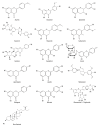A Network Pharmacology Study on the Mechanisms of the Herbal Extract, Christina Loosestrife, for the Treatment of Nephrolithiasis
- PMID: 32241963
- PMCID: PMC7154562
- DOI: 10.12659/MSM.919360
A Network Pharmacology Study on the Mechanisms of the Herbal Extract, Christina Loosestrife, for the Treatment of Nephrolithiasis
Abstract
BACKGROUND This study aimed to undertake a network pharmacology analysis to identify the active compounds of the herbal extract Christina Loosestrife, or Lysimachia Christinae (Jin Qian Cao), in the treatment of nephrolithiasis. MATERIAL AND METHODS The active components of Christina Loosestrife were identified from the Traditional Chinese Medicine Systems Pharmacology (TCMSP) database and analysis platform and the online Taiwan TCM database. The potentially active compounds were screened based on their parenteral bioavailability identified from the TCMSP database. The PharmMapper integrated pharmacophore matching platform was used for target identification of active compounds in nephrolithiasis. The identified active compounds were validated by molecular docking using the systemsDock network pharmacology website. Biological functions and pathway outcomes of effective targets were analyzed using the Metascape gene annotation resource. The results were used to construct the pharmacological networks, which were visualized and integrated using Cytoscape software. RESULTS There were 16 active compounds of Christina Loosestrife and 11 nephrolithiasis-associated targets that were obtained. Functional enrichment analysis showed that Christina Loosestrife might exert its therapeutic effects by regulating pathways that included purine salvage, interleukin-4 (IL-4) and IL-13 signaling, and neutrophil degranulation. CONCLUSIONS Network pharmacology analysis of the herbal extract, Christina Loosestrife, identified multiple active compounds, targets, and pathways involved in the effects on nephrolithiasis.
Conflict of interest statement
None.
Figures





Similar articles
-
["Multi-component-multi-target-multi-pathway" mechanism of Kuihua Hugan Tablets based on network pharmacology].Zhongguo Zhong Yao Za Zhi. 2019 Apr;44(7):1464-1474. doi: 10.19540/j.cnki.cjcmm.20181214.003. Zhongguo Zhong Yao Za Zhi. 2019. PMID: 31090306 Chinese.
-
[Material basis and mechanism of Xiao'er Resuqing Oral Liquid on hand, foot and mouth disease based on network pharmacology and molecular docking].Zhongguo Zhong Yao Za Zhi. 2020 Dec;45(23):5745-5752. doi: 10.19540/j.cnki.cjcmm.20201022.401. Zhongguo Zhong Yao Za Zhi. 2020. PMID: 33496115 Chinese.
-
Marantodes pumilum: Systematic computational approach to identify their therapeutic potential and effectiveness.J Ethnopharmacol. 2022 Jan 30;283:114751. doi: 10.1016/j.jep.2021.114751. Epub 2021 Oct 15. J Ethnopharmacol. 2022. PMID: 34662662
-
Traditional Chinese medicine network pharmacology: theory, methodology and application.Chin J Nat Med. 2013 Mar;11(2):110-20. doi: 10.1016/S1875-5364(13)60037-0. Chin J Nat Med. 2013. PMID: 23787177 Review.
-
Uncovering the pharmacological mechanism of motherwort (Leonurus japonicus Houtt.) for treating menstrual disorders: A systems pharmacology approach.Comput Biol Chem. 2020 Dec;89:107384. doi: 10.1016/j.compbiolchem.2020.107384. Epub 2020 Sep 29. Comput Biol Chem. 2020. PMID: 33017723 Review.
Cited by
-
Taraxasterol acetate targets RNF31 to inhibit RNF31/p53 axis-driven cell proliferation in colorectal cancer.Cell Death Discov. 2021 Apr 6;7(1):66. doi: 10.1038/s41420-021-00449-5. Cell Death Discov. 2021. PMID: 33824292 Free PMC article.
-
Network Pharmacology and Molecular Docking Analysis on Molecular Targets and Mechanisms of "Chuanxiong Rhizoma: Radix Salviae miltiorrhizae" Herb Couples in the Treatment of Preeclampsia.Evid Based Complement Alternat Med. 2022 Sep 7;2022:2568008. doi: 10.1155/2022/2568008. eCollection 2022. Evid Based Complement Alternat Med. 2022. Retraction in: Evid Based Complement Alternat Med. 2023 Aug 2;2023:9840103. doi: 10.1155/2023/9840103. PMID: 36118076 Free PMC article. Retracted.
-
Therapeutic effects of Chinese herbal medicines for treatment of urolithiasis: A review.Chin Herb Med. 2023 Sep 27;15(4):526-532. doi: 10.1016/j.chmed.2023.09.001. eCollection 2023 Oct. Chin Herb Med. 2023. PMID: 38094012 Free PMC article. Review.
-
Citrus Flavone Tangeretin Inhibits CRPC Cell Proliferation by Regulating Cx26, AKT, and AR Signaling.Evid Based Complement Alternat Med. 2022 Jan 24;2022:6422500. doi: 10.1155/2022/6422500. eCollection 2022. Evid Based Complement Alternat Med. 2022. PMID: 35111229 Free PMC article.
-
Elaborate the Mechanism of Ancient Classic Prescriptions (Erzhi Formula) in Reversing GIOP by Network Pharmacology Coupled with Zebrafish Verification.Evid Based Complement Alternat Med. 2022 Jan 10;2022:7019792. doi: 10.1155/2022/7019792. eCollection 2022. Evid Based Complement Alternat Med. 2022. PMID: 35047047 Free PMC article.
References
-
- Zeng G, Mai Z, Xia S, et al. Prevalence of kidney stones in China: An ultrasonography based cross-sectional study. BJU Int. 2017;120(1):109–16. - PubMed
-
- Huang WY, Chen YF, Carter S, et al. Epidemiology of upper urinary tract stone disease in a Taiwanese population: A nationwide, population based study. J Urol. 2013;189(6):2158–63. - PubMed
-
- Zhou J, Jin J, Li X, et al. Total flavonoids of Desmodium styracifolium attenuates the formation of hydroxy-L-proline-induced calcium oxalate urolithiasis in rats. Urolithiasis. 2018;46(3):231–41. - PubMed
-
- Miyaoka R, Monga M. Use of traditional Chinese medicine in the management of urinary stone disease. Int Braz J Urol. 2009;35(4):396–405. - PubMed
-
- Chinese Pharmacopoeia Commission. Pharmacopoeia of the People’s Republic of China (2015 edition) China Medical Science and Technology Press; Beijing, China: 2015.
MeSH terms
Substances
LinkOut - more resources
Full Text Sources

